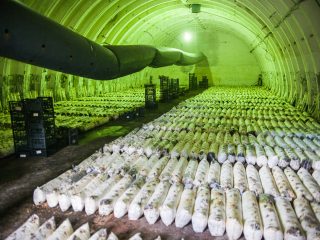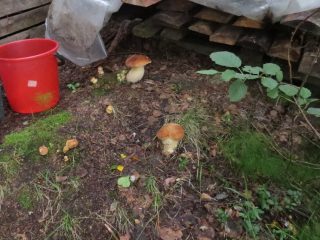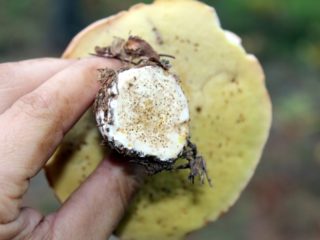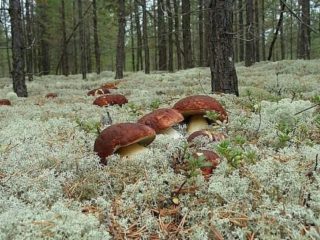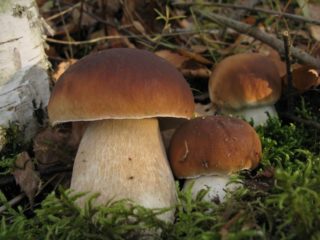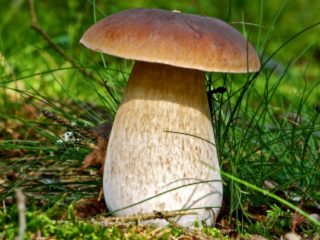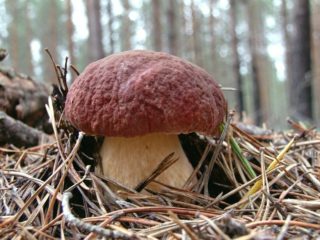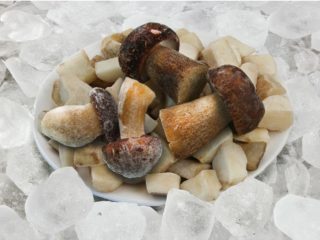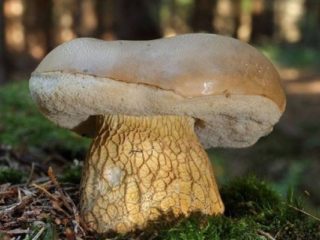Content
It is widely believed that if a porcini mushroom turns blue when cut, then the specimen found is a poisonous counterpart. This is only partly true, since the color of the pulp changes in a large number of species, both edible and toxic. In order not to accidentally pick up a dangerous variety, it is recommended to study other distinctive features of false boletus mushrooms.
Do porcini mushrooms turn blue when cut?
Genuine porcini mushroom (lat. Boletus edulis), also known as boletus, never turns blue when cut. This is what distinguishes it from many subspecies that are similar to it. However, most often they are poisonous or conditionally edible. On the other hand, there are many exceptions to this rule, when the flesh of the double takes on a bluish tint and even turns black, but it is still considered fit for consumption. A striking example here is the chestnut flywheel (lat. Boletus badius), which has excellent taste.
Thus, blueness is a distinctive feature of false twins, but it is not always an indicator of the toxicity of the found fruiting bodies.
Why does the porcini mushroom turn blue?
Inexperienced mushroom pickers mistakenly believe that if a false porcini mushroom turns blue when cut, this indicates the presence of toxins in its pulp. Changes in color only indicate that its fibers have come into contact with oxygen and an oxidation reaction has begun. This process does not affect the taste of the fruiting body in any way.
Sometimes the flesh turns bluish within 10-15 minutes, however, in some varieties the fibers change color in a matter of seconds. Usually blueness affects any part of the fruiting body, but there are also false porcini mushrooms that turn blue only under the cap.
Other mushrooms similar to porcini that turn blue
There are a large number of mushrooms that look like porcini mushrooms, but their flesh turns blue when cut. The most dangerous among these false species is the satanic boletus (lat. Boletus satanas).
It is distinguished from a genuine boletus by its stem, which has a bright red color. In addition, it has a whitish mesh pattern. The tubular layer of the double is orange. It is these signs that indicate that the find is a poisonous disease, which under no circumstances should be eaten. 5-10 g of the pulp of this double is enough to cause severe poisoning in a person. Eating large quantities of fruiting bodies can result in death.
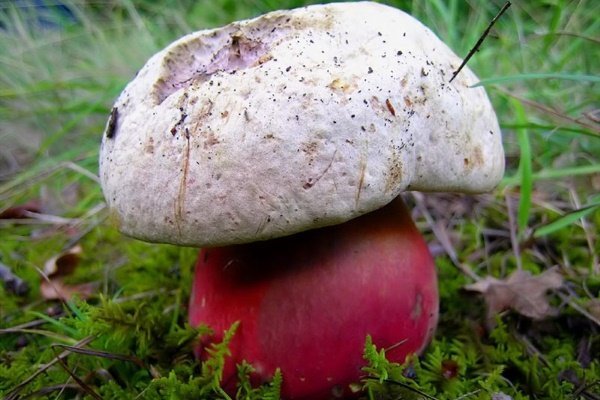
The leg of the satanic boletus is very powerful and wide
If the specimens found are darkened, these could be Polish mushrooms, also known as chestnut boletus mushrooms (lat. Boletus badius) - common counterparts of the white boletus mushroom. This is an edible variety that is excellent for eating fried, boiled, dried and pickled. The upper part of the cap is brown or reddish-brown. The hymenophore of the mushroom is yellow-green in color, but when pressed it turns blue, like the white flesh, which darkens when cut. After heat treatment, the blue discoloration disappears quite quickly.
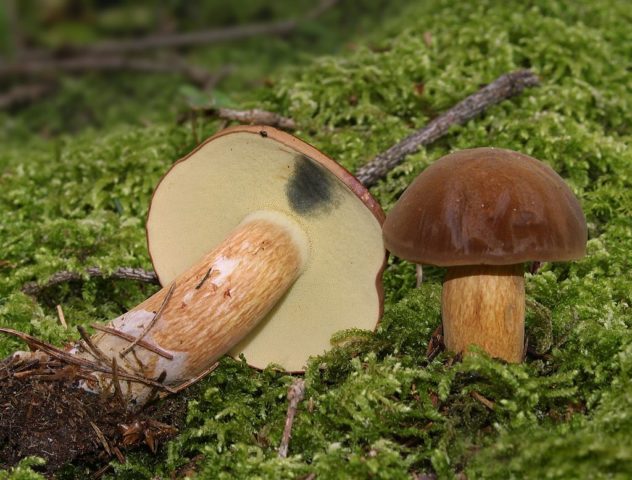
Chestnut mushrooms are very similar to genuine boletus mushrooms; the easiest way to distinguish them is by the blue flesh at the cut site
Another species that is similar in appearance to a genuine boletus is the bruise or blue gyroporus (lat. Gyroporus cyanescens). It is listed in the Red Book of Russia, as its numbers have greatly decreased recently. The distribution area of the bruise covers deciduous and mixed forests; most likely this species can be found under birch, chestnut or oak trees.
Gyroporus was very popular among mushroom pickers - it could be pickled, boiled and fried.
It is distinguished from a real boletus by its light color - the cap of the boletus is most often grayish or cream-colored.
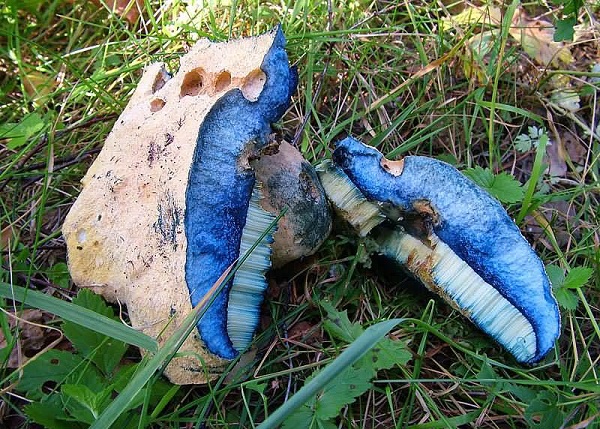
The fruiting body of the bruise on the cut becomes bright blue, at some point reaching a rich azure hue
If a porcini mushroom turns black when cut
If the white mushroom found when cut first turns blue and then turns black, it is most likely a red boletus (lat. Leccinum aurantiacum).It differs from the genuine boletus in the more saturated color of the cap.
This is an edible variety with excellent taste.
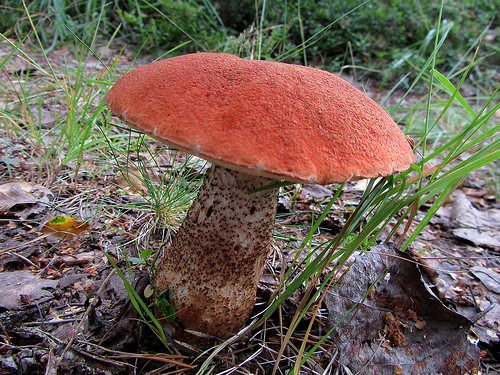
The cap of the red boletus has a rich brown color with an admixture of orange
The flesh of the hornbeam, which is also called the hornbeam or gray boletus (lat. Leccinum carpini), also turns blue and then turns black. Another sign by which this false species can be identified is the faint wrinkling of ripe specimens. Old fruits completely shrink, becoming covered with deep furrows.
Just like red boletus, hornbeam can be eaten, although its flesh turns blue when cut.
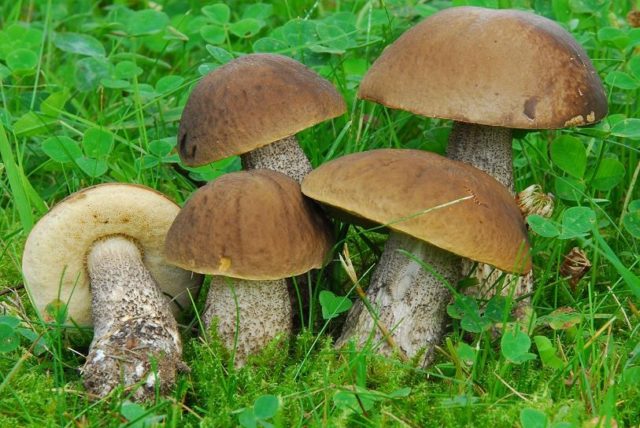
The color of the hornbeam cap is changeable - it can be brown-gray, ashy or ocher.
Conclusion
If the porcini mushroom turns blue when cut, then the specimen found is one of the false species. On the other hand, this does not mean that the fruiting body of the double is poisonous - there are a large number of edible varieties that change the color of the flesh at the cut or at the point of impact. In order to accurately determine the value of a find, it is necessary to know other distinctive external signs of poisonous doubles. These include the color of the cap and legs, the presence of mesh formations on false species, smell, etc.
You can learn more about how the stem of a false porcini mushroom turns blue from the video below:
